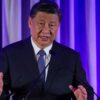Finance
How the U.S. has old price lists thru historical past — and why Trump is other, economists say
Delivery bins are noticeable on the Port of Montreal in Montreal, Canada, on Feb. 3, 2025.
Andrej Ivanov | Afp | Getty Photographs
President Donald Trump imposed vast price lists on China on Tuesday, future tariff blackmails dangle over alternative primary buying and selling companions like Canada, the Eu Union and Mexico.
That can top some to surprise: How have price lists been wielded thru U.S. historical past, and is Trump distinctive in his importance of them?
The ‘3 Rs’ of price lists
The U.S. has old price lists since its launch within the 18th century.
If truth be told, the Tariff Work of 1789 was once a number of the first expenses ever handed by way of Congress.
Since next, the U.S. has old price lists to succeed in 3 vast objectives, stated Douglas Irwin, an economics schoolteacher at Dartmouth School and occasion president of the Financial Historical past Affiliation.
Irwin yelps them the “three Rs” — income, restriction (import obstacles to offer protection to home business) and reciprocity (a bargaining chip to scale down offers with alternative international locations).
The use of price lists for income
Price lists are taxes on U.S. imports, paid by way of the entity that’s uploading the international just right. The ones taxes lift income to assistance charity the government.
For kind of the primary 3rd of the society’s historical past — from its launch till the Civil Battle — the income motivation was once “paramount” as a motive force to impose import tasks, Irwin stated. The government depended on price lists for roughly 90% or extra of its income all over that duration, he stated.
However issues modified upcoming the Civil Battle, Irwin stated. The U.S. began to impose alternative taxes, like excise taxes, that made the society much less reliant on price lists.
Price lists generated about half of federal income from about 1860 to 1913, when the source of revenue tax was once created, Irwin stated.
The dimensions of the federal government expanded considerably within the Nineteen Thirties — with the establishing of Brandnew Trade in methods like Social Safety — and upcoming for protection spending all over WWII and the Chilly Battle, stated Kris James Mitchener, an economics schoolteacher at Santa Clara College who research financial historical past and political economic system.
Lately, “tariffs simply cannot raise enough revenue to fund government expenditure,” Mitchener stated. “There’s no possible way you could support the size of the U.S. military on tariff revenue.”
Restriction and reciprocity
From the Civil Battle to the Superior Melancholy, the U.S. basically old price lists as a restrictive measure on imports, to insulate the home marketplace from international pageant, Irwin stated.
As an example, the Tariff Work of 1930, popularly referred to as the Smoot-Hawley Tariff, levied protecting price lists on kind of 800 to 900 various kinds of items, accounting for roughly 25% of all items imported to the U.S., Mitchener stated.
Upcoming, the post-Melancholy time — particularly the post-International Battle II duration — ushered in an time of “reciprocity,” Irwin stated.
The U.S. helped develop the General Agreement on Tariffs and Trade in 1948, the precursor to the International Industry Group, which i’m ready world regulations for commerce and ushered in an time of low price lists.
Extra from Non-public Finance:
What the ‘mom of all commerce wars’ can educate us about U.S. price lists
May Trump’s price lists change the source of revenue tax?
Stockpiling forward of upper price lists is a bulky mistake
That stated, the U.S. additionally old price lists as a reciprocal bargaining chip earlier than WWII.
As an example, earlier than the U.S. annexed Hawaii, it signed a free-trade assurance with the Kingdom of Hawaii in 1875. The treaty allowed for duty-free imports of Hawaiian sugar and alternative agricultural merchandise into the U.S. In alternate, the U.S. got exclusive access to the harbor that may upcoming be referred to as Pearl Harbor.
How the president’s tariff energy grew
U.S. import taxes earlier than the WWII time had been good-looking top, starting from 20% to 50%, on occasion even attaining 60%, Irwin stated. They have got been “very low” since 1950 or so, he stated.
The common obligation on items topic to a tariff was once about 2% to 4% within the 2010s earlier than Trump’s first time period, Mitchener stated.
“That’s what President Trump is trying to overturn, this sort of low period of tariffs we’ve had since World War II,” Irwin stated.

Prior to 1934, it was once Congress — now not presidents — that had energy over tariff charges and negotiations, stated Andrew Wender Cohen, a historical past schoolteacher at Syracuse College.
However Democrats — next referred to as the political celebration of unfastened commerce — had a huge majority across the Brandnew Trade in time and handed the Reciprocal Trade Agreements Act of 1934, granting the president the correct to barter price lists in sure circumstances, Cohen stated.
“That’s when the president gains a much more substantial authority,” Cohen stated.
That energy speeded up upcoming 1948 all over the “transformation of the whole global economic order,” he stated.
Why Trump tariff coverage is ‘very bizarre,’ economists say
President Donald Trump within the Oval Administrative center of the White Area on Feb. 03, 2025.
Anna Moneymaker | Getty Photographs Information | Getty Photographs
That stated, Trump’s importance of tariff coverage is “very unusual” amongst fashionable U.S. presidents, Cohen stated.
For one, Trump “likes all three Rs” — income, restriction and reciprocity, Irwin stated.
As an example, at the marketing campaign path, he advised that price lists may change the U.S. source of revenue tax to charity the federal government. He said all over his marketing campaign that they might develop U.S. manufacturing unit jobs and has threatened to use them to strongarm Denmark to surrender Greenland.
Alternatively, there are tradeoffs, Irwin stated. As an example, limiting imports moderately negates price lists’ talent to lift income, as it diminishes the tax bottom for price lists, he stated. (The ones extra tasks would possibly motive firms to import much less or push public to shop for much less, for example.)
“You can’t really achieve all three objectives at same time,” he stated.
Moreover, negative earlier president has attempted to hyperlink a U.S. drug situation to commerce coverage, as Trump did with fentanyl.
“That’s a novel take,” Mitchener stated.
Many presidents have old price lists. As an example, George W. Bush, Ronald Reagan and Richard Nixon implemented price lists to offer protection to the U.S. metal business, as Trump did in his first term, Irwin stated.
“What’s unusual about Trump is, he’s not just picking out particular industries that he thinks are of strategic importance, but he’s blocking imports across the board almost with some of these countries,” Irwin stated.
Trump imposed a ten% extra tariff on all Chinese language items, for instance, and threatened a 25% tariff on imports from Canada and Mexico.
“No president in recent memory has really used tariffs across the board or in a broad-brush way to achieve various objectives,” Irwin stated. “They’ve sort of adhered to the rule that we belong to the WTO. That means we keep our tariffs low as long as other countries keep their tariffs low.”
Cohen yes.

World commerce treaties, just like the United States-Mexico-Canada Assurance (USMCA) Trump signed in his first time period, determine a mechanism for international locations to record grievances for alleged unfair commerce practices, Cohen stated. Countries can usually lift price lists as a retaliatory measure if commerce regulations are breached, in keeping with the treaty phrases, he stated.
Trump’s fresh unilateral tariff bulletins are distinctive on this regard, he stated.
“I can’t think of any precedent for that,” Cohen stated.
“While the executive branch was given much more power since 1934, it’s always been subject to the specific terms of the agreements,” he stated.





